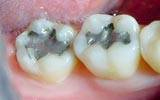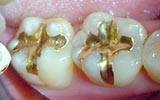Our Welcoming Reception & 1st Waiting Area
Our Ground Floor Operatory
Our Ground Floor Operatory
Our Laboratory
Our Display Area With Updated Oral Hygiene Measures
Our First Floor Operatory
Our First Floor Operatory
Fillings

If a single spot on one of your teeth is not cleaned daily, the remaining bacteria will transform themselves into a sticky film substance called plaque. The plaque will produce acids which eat away at the enamel of the tooth and will eventually cause cavities. When the cavity gets through the enamel, into the underlying tooth structure (the dentin), repair or restoration is necessary.
Frequently Asked Questions
- How do I know if I need a filling?
- Can all teeth with holes or fractures be filled?
- What are the different kinds of material a dentist can use to fill my tooth?
- What is an amalgam filling?
- Should I have my amalgam fillings replaced?
- If amalgam is so great, why does my dentist use white or 'tooth-coloured' fillings?
- How are fillings done?
- What are advantages and disadvantages of gold fillings?
- What are advantages and disadvantages of composite fillings?
- Can fillings be repaired rather than replaced?
- How long do fillings last?
- Is it possible to avoid fillings?
Still have questions?
Ask us for more information.
Q: How do I know if I need a filling?
A: You may not know if you need fillings in your teeth. Many small to medium holes in teeth are asymptomatic, giving no pain. In fact, decay can sometimes eat out two-thirds of the tooth from the inside and you would have no idea it is happening.
Dental radiographs (X-rays), which are taken on a regular basis as part of your check-up, may show early decay that has not yet given any symptoms. You may be able to see a change in the colour on some of your teeth which may indicate early decay.
If your teeth are sensitive to hot, cold, or sweet food and drink, you may need fillings. All persistently sensitive teeth should be checked by your dentist. Toothache that lasts for more than a few minutes at a time should be investigated by your dentist. Teeth that cause severe pain may require fillings, or in some cases will require more extensive treatment such as root canal treatment.
Q: Can all teeth with holes or fractures be filled?
A: Most teeth with small to moderate decay or fractures are easily restored to function with fillings. Where decay is extensive or fractures are large, more complex treatment may be required. Some teeth can be so badly broken down or fractured that they are unable to be saved.
Q: what are the different kinds of material a dentist can use to fill my tooth?
A: A dentist can use various kinds of filling material to restore your tooth which varies from patient to patient. Basically he will use the following kinds of filling material to fill your tooth.
- Silver Amalgam
- Glass Ionomer
- Light Cure Composite Resin
- Gold Filling
- Light Cure Glass Ionomer




Q: What is an amalgam filling?
A: Amalgam fillings are used to repair teeth for hundreds of thousands of people each year in India. Dental amalgam is a popular choice, as it is strong, relatively inexpensive and can last a lifetime.
Q: Should I have my amalgam fillings replaced?
A: Dentists replace amalgam fillings for a variety of reasons including recurring decay, fracture, endodontic treatment and appearance. If you seek replacement of quite satisfactory amalgam fillings for other reasons, such as a concern about the effects of mercury, you may create problems that otherwise would not have occurred, such as:
- Possible damage to or weakening of teeth.•Sensitivity or pain after the filling.
- Financial problems.
- Gold fillings is stronger than amalgam fillings.
- Gold fillings last a long time.
- Gold fillings costs more than other kinds of fillings.
- Gold fillings and crowns are indirect fillings, so they require at least two appointments.
- The gold colour may not appeal to people who want a "natural" look.
- Bleaching is much cheaper than crowns or veneers and research indicates that it is completely effective in more than 90% of people.
- The composite bonds to further support the remaining tooth structure helping to prevent breakage and damage to your tooth.
- They look more natural as they are color blended to match your natural tooth color. These fillings are often used to improve the appearance of misshapen, chipped or discolored teeth.
- Composite fillings last from six to twelve years or more.
- The procedure usually takes just one visit to your dentist.
- There is very little sensitivity to hot or cold items, often experienced with amalgam fillings.
- The dentist won't need to drill as much of the tooth structure as the composite is applied in layers.
- Composite resin fillings require more time to apply than amalgam fillings.
- As a result of the time required there is an increased cost for placing composite fillings.
Q: If amalgam is so great, why does my dentist use white or 'tooth-coloured' fillings?
A: White fillings have been used in front teeth for decades. In recent times, scientists have developed strong white filling materials for back teeth to be used as an alternative to the dark colour of amalgam. The reason for this is the public demand for tooth-coloured fillings in visible areas of the mouth. These materials have not been in use for enough time to test their long-term comparison with amalgam but results are encouraging.
Q: How are fillings done?
A: Tooth preparation, prior to filling placement, is usually done under local anaesthesia (making the tooth numb). Once all the decay is removed and the tooth is washed and dried, the filling is packed into the cavity and it sets. After the filling is placed, it is shaped to match the original tooth contour and the bite is checked.
Q: What are advantages and disadvantages of gold fillings?
A: The following are the advantages and disadvantages of gold fillings:
Advantages:
Disadvantages:
Q: What are advantages and disadvantages of composite fillings?
A: The following are the advanages and disadvantages of composite fillings:
Advantages :Disadvantages :
Q: Can fillings be repaired rather than replaced?
A: Some fillings can be repaired when they fracture, or the tooth around them fractures, but only if there is no tooth decay present.
Q: How long do fillings last?
A: The position, shape, material, and functioning pressure, all influence how long dental fillings will last. Larger fillings that bear a heavy functional load tend to break down more quickly than smaller fillings that bear little force. This is why it is impossible and meaningless to try to state categorically how long fillings should last.
However, when placing a filling, the dentist may have an idea of the expectation of the life of the filling. For example, a very small filling in the groove of a tooth away from biting pressure could be there for decades whereas a very large one in the mouth of a person who grinds their teeth may be lucky to last a few years and really should have a crown.
In a checkup, your dentist is constantly monitoring the state of your fillings, looking for signs of weakness, cracking, decay or discolouration.
Q: Is it possible to avoid fillings?
A: With proper attention to diet, oral self-care, regular dental check-ups, and the correct use of mouthguards to prevent injury, the need for fillings can be eliminated, and the frequency of filling re-placement can be extended.
Click Here To See Photo Gallery : Fillings
